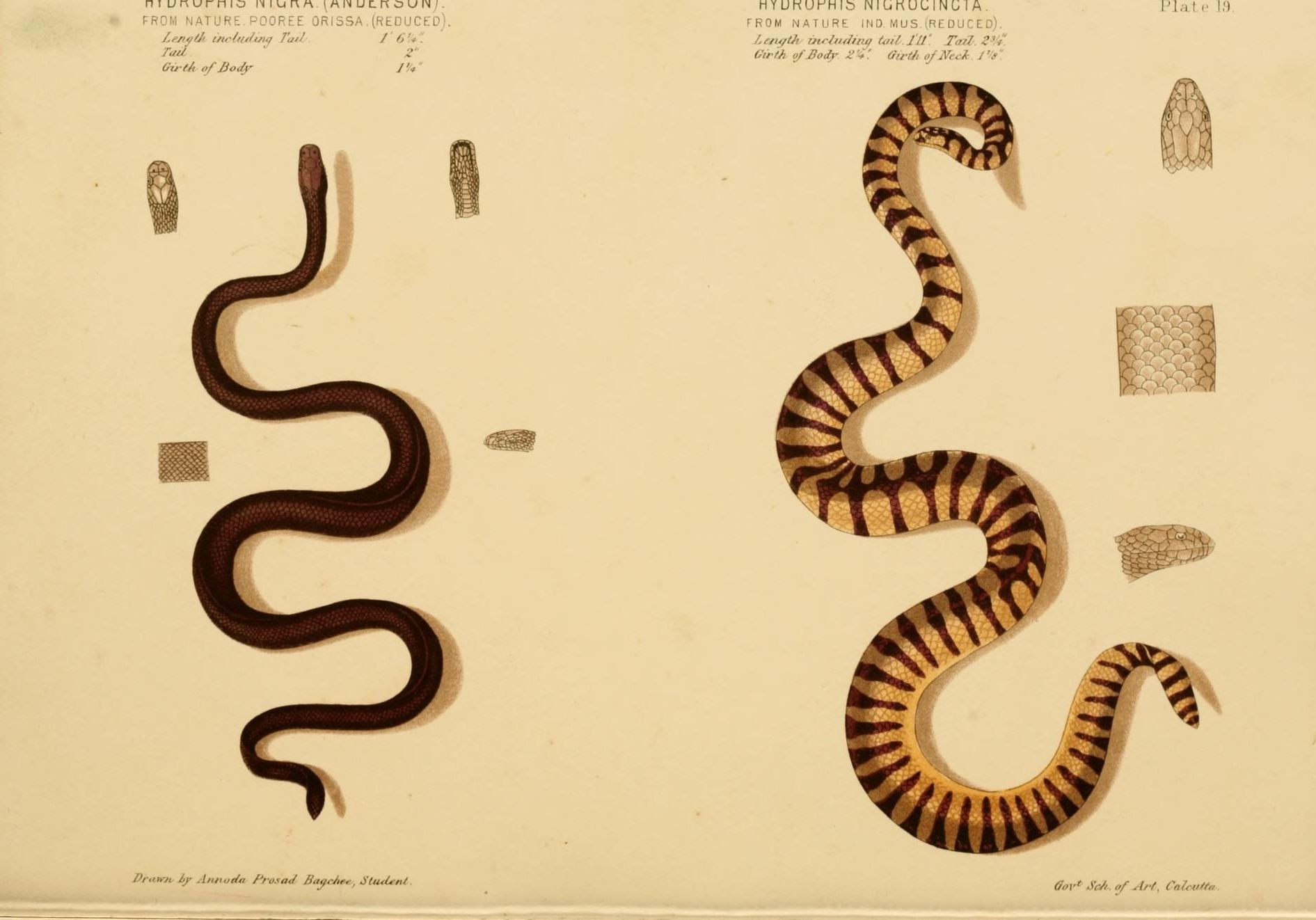| Citation |
|
Description |
Brief Summary
Notes
learn more about this article
Holotype: ZMH 404 .
Type-locality: Java.
Creative Commons Attribution Non Commercial 3.0 (CC BY-NC 3.0)
© Mohammadi, Shabnam Source: Snake Species of the World
TRUSTED
article rating from 0 people Default rating: 2.5 of 5
comment on or rate this article
Common Names
learn more about this article
Viperine sea snake
Creative Commons Attribution Non Commercial 3.0 (CC BY-NC 3.0)
© Mohammadi, Shabnam Source: Snake Species of the World
TRUSTED
article rating from 0 people Default rating: 2.5 of 5
comment on or rate this article
Distribution
Range Description
learn more about this article
This species is known from the Arabian Gulf to Pakistan, around India to Indonesia and southern China (Heatwole 1999). There is record of a single specimen being caught off Phuket Island from the west coast of peninsular Thailand (Rasmussen 1985). The species appears to be very rare in that area. There are no records from the Philippines (J. Gatus pers. comm. 2009).
Creative Commons Attribution Non Commercial Share Alike 3.0 (CC BY-NC-SA 3.0)
© International Union for Conservation of Nature and Natural Resources Source: IUCN
TRUSTED
article rating from 0 people Default rating: 2.5 of 5
comment on or rate this article
learn more about this article
Continent: Asia
Distribution: Indian Ocean, India, Pakistan, Sri Lanka, South Chinese Sea, northeast to coastal region of Fujian and Strait of Taiwan, Vietnam, Persian Gulf (Oman, United Arab Emirates (UAE), etc.) to Bay of Bengal coasts of Malay Peninsula and Indonesia (Java, Borneo, Sumatra) Gulf of Thailand, Myanmar (= Burma).
Type locality: Java.
Creative Commons Attribution Non Commercial Share Alike 3.0 (CC BY-NC-SA 3.0)
© Peter Uetz Source: The Reptile Database
TRUSTED
article rating from 0 people Default rating: 2.5 of 5
comment on or rate this article
learn more about this article
Persian Gulf east through northern Indian Ocean to Malay Peninsula and Indonesia (Borneo, java, Sumatra); South China Sea.
Creative Commons Attribution Non Commercial 3.0 (CC BY-NC 3.0)
© Mohammadi, Shabnam Source: Snake Species of the World
TRUSTED
article rating from 0 people Default rating: 2.5 of 5
comment on or rate this article
ECOLOGY
Habitat
Habitat and Ecology
learn more about this article
Habitat and Ecology
The maximum size is approximately 97 cm TL (captured in a trawl in Goa, India; A. Lobo pers. comm. 2009). Feeds on spiny flatheads in India (A. Lobo pers. comm. 2009) and on eels and gobies (Voris and Voris 1983). Found in muddy soft bottom habitats.
An average of 3-4 large young and high reproductive effort (Lemen and Voris 1981).
It generally occurs in slighter deeper waters (15 - 30m) ( A. Lobo pers. comm.).
Systems
Marine
Creative Commons Attribution Non Commercial Share Alike 3.0 (CC BY-NC-SA 3.0)
© International Union for Conservation of Nature and Natural Resources Source: IUCN
TRUSTED
article rating from 0 people Default rating: 2.5 of 5
comment on or rate this article
CONSERVATION
Conservation Status
IUCN Red List Assessment
learn more about this article
Red List Category
LC
Least Concern
Red List Criteria
Version
3.1
Year Assessed
2010
Assessor/s
Rasmussen, A., Sanders, K. & Lobo, A.
Reviewer/s
Livingstone, S.R., Elfes, C.T., Polidoro, B.A. & Carpenter, K.E. (Global Marine Species Assessment Coordinating Team)
Contributor/s
Justification
This species is widespread, although thought to be naturally rare. There are several specimens in museum collections. There are no known major threats as it lives in deeper waters, although it is captured occasionally in trawl fisheries bycatch. This species is listed as Least Concern.
Creative Commons Attribution Non Commercial Share Alike 3.0 (CC BY-NC-SA 3.0)
© International Union for Conservation of Nature and Natural Resources Source: IUCN
TRUSTED
article rating from 0 people Default rating: 2.5 of 5
comment on or rate this article
Trends
Population
learn more about this article
Population
Generally rare throughout its range.
This is quite a rare species caught in trawls in Goa, India (A. Lobo pers. comm. 2009). Also rare in trawls in the Andaman Sea and uncommon on the west coast of Thailand, but more common in Viet Nam (A. Rasmussen pers. comm. 2009).
Six specimens (out of 83) were collected from fishermen in Makassar, South Sulawesi in March and April 2010. Reportedly caught in nets (using lamps) near coral reefs around Pulau Baranglompo (K. Sanders and Mumpuni pers. comms. 2010).
Population Trend
Unknown
Creative Commons Attribution Non Commercial Share Alike 3.0 (CC BY-NC-SA 3.0)
© International Union for Conservation of Nature and Natural Resources Source: IUCN
TRUSTED
article rating from 0 people Default rating: 2.5 of 5
comment on or rate this article
Threats
learn more about this article
Major Threats
It is caught as bycatch in trawl fishing operations (A. Lobo pers. comm. 2009).
Creative Commons Attribution Non Commercial Share Alike 3.0 (CC BY-NC-SA 3.0)
© International Union for Conservation of Nature and Natural Resources Source: IUCN
TRUSTED
article rating from 0 people Default rating: 2.5 of 5
comment on or rate this article
Management
Conservation Actions
learn more about this article
Conservation Actions
There are no species-specific conservation measures in place.
Creative Commons Attribution Non Commercial Share Alike 3.0 (CC BY-NC-SA 3.0)
© International Union for Conservation of Nature and Natural Resources Source: IUCN
TRUSTED
article rating from 0 people Default rating: 2.5 of 5
comment on or rate this article |

